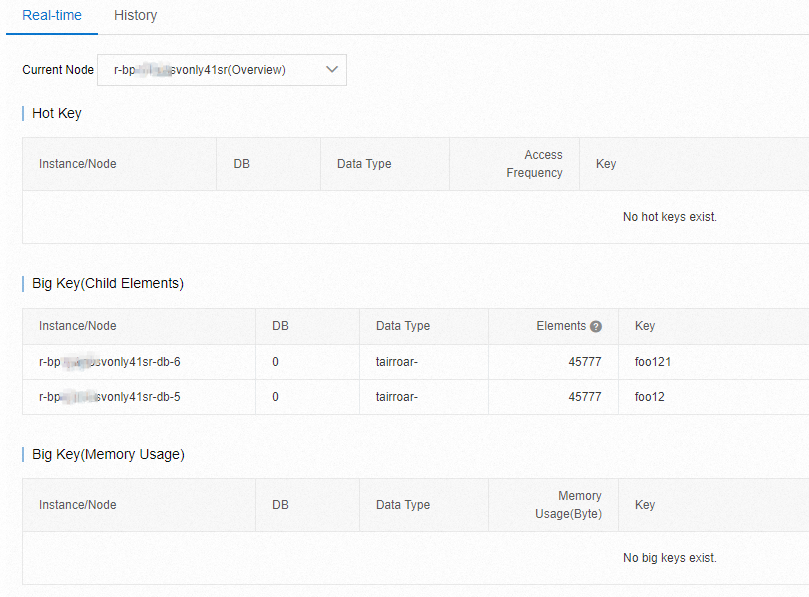Tair (Redis OSS-compatible) integrates the key analysis feature of Database Autonomy Service (DAS) to provide the top key statistics feature. The top key statistics feature provides real-time and historical statistics about large keys and hotkeys, including the number of elements in large keys and the access frequency of hotkeys. When the memory usage or CPU utilization of an instance increases, the top key statistics feature can help you quickly identify large keys and hotkeys to resolve performance issues in the instance.
Prerequisites
The instance is a Redis Open-Source Edition instance that runs Redis 5.0 or later or a Tair (Enterprise Edition) DRAM-based or persistent memory-optimized instance.
Statistical ranking mechanisms for large keys and hotkeys
Key type | Statistical ranking mechanism |
Large keys |
Note Only instances that are compatible with Redis 5.0 or later are supported.
Note Only Tair (Enterprise Edition) instances of version 6.0 or later are supported.
Note Keys that have not been accessed for a long period of time may not be included in the statistical ranking. You can use the offline key analysis feature to obtain information about large keys, such as the memory usage of keys, the distribution of keys, the memory usage and distribution of elements in keys, and the distribution of time-to-live (TTL) values across keys. For more information, see Use the offline key analysis feature. |
Hotkeys | Tair (Redis OSS-compatible) uses efficient sorting and statistical algorithms based on the Least Recently Used (LRU) key eviction policy to identify hotkeys in an instance. Note For Redis Open-Source Edition 7.0.18, 6.0.2.9, or 5.5.2.9 instances or Tair DRAM-based instances of version 5.0.50, 24.5.1.0, or later, the following enhancements to hotkeys are made:
|
Procedure
Log on to the console and go to the Instances page. In the top navigation bar, select the region in which the instance that you want to manage resides. Then, find the instance and click the instance ID.
In the left-side navigation pane, choose .
Click the Real-time tab to view real-time data or click the History tab to view historical data based on your business requirements.
Figure 1. Key analysis
 Note
NoteIf the instance is a cluster instance or a read/write splitting instance, you can select a node from the Current Node drop-down list.
On the History tab, you can query the historical large keys and hotkeys within the previous four days. The time range to query cannot exceed 3 hours. For example, if the current time is 16:00 on July 15, 2021, you can query the large keys and hotkeys from 16:00 on July 11 to 16:00 on July 15. If you set the beginning of the time range to query to 16:00 on July 11, the end of the time range to query cannot be later than 19:00 on July 11.
Related API operations
DAS API operation | Description |
Queries the hotkeys and large keys in the memory in real time. | |
Queries the top 20 hotkeys over a specific period of time. | |
Queries the top 20 large keys over a specific period of time. | |
Queries the hotkeys of an instance. |